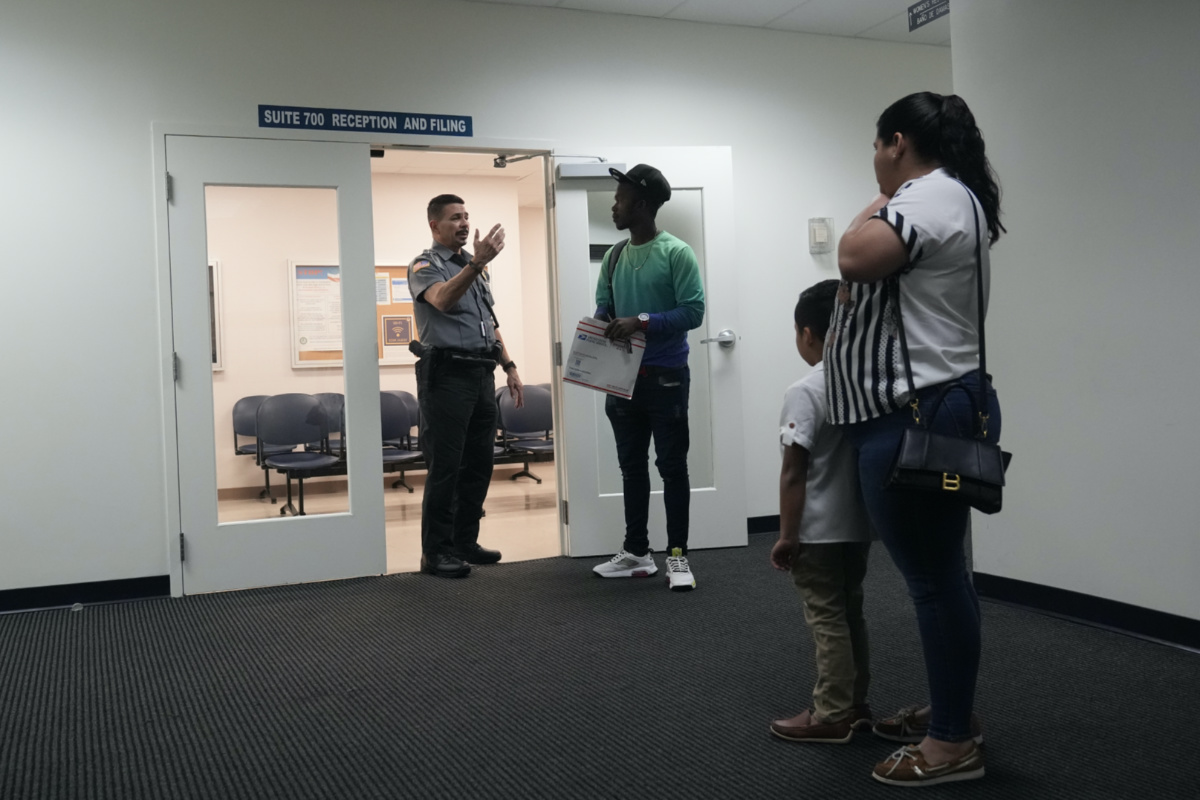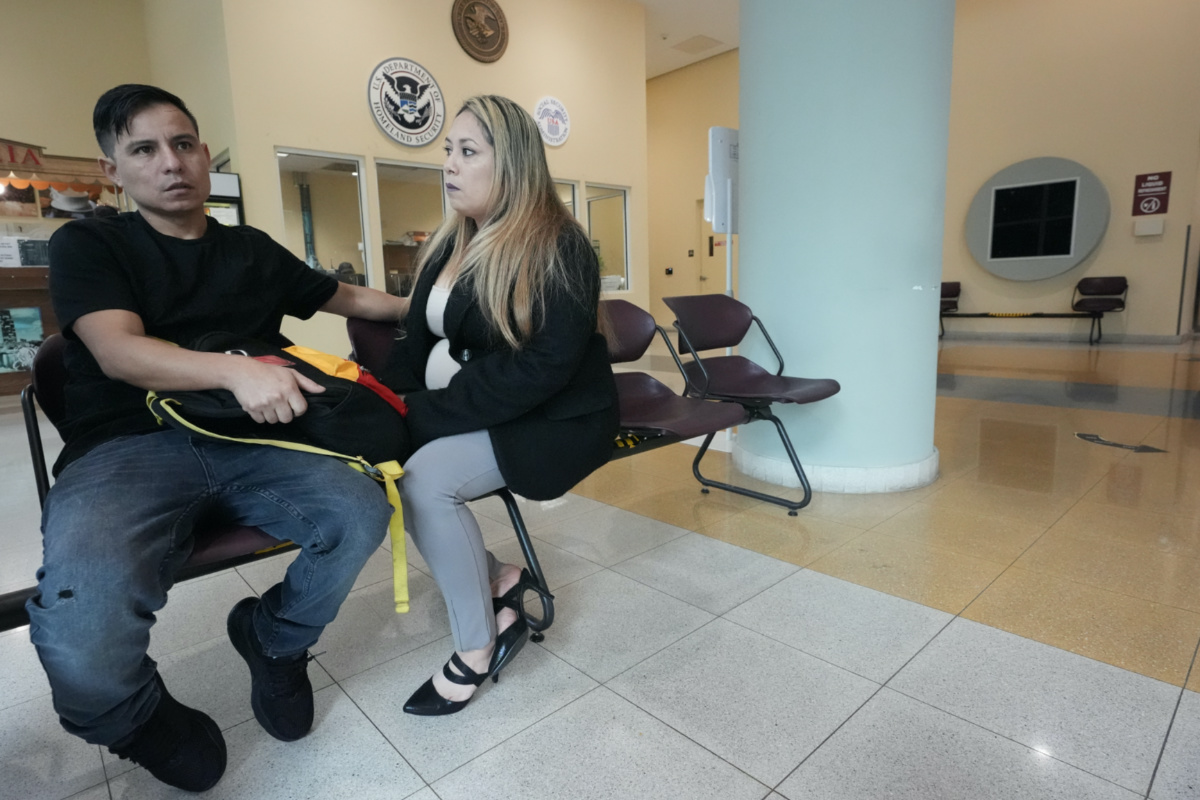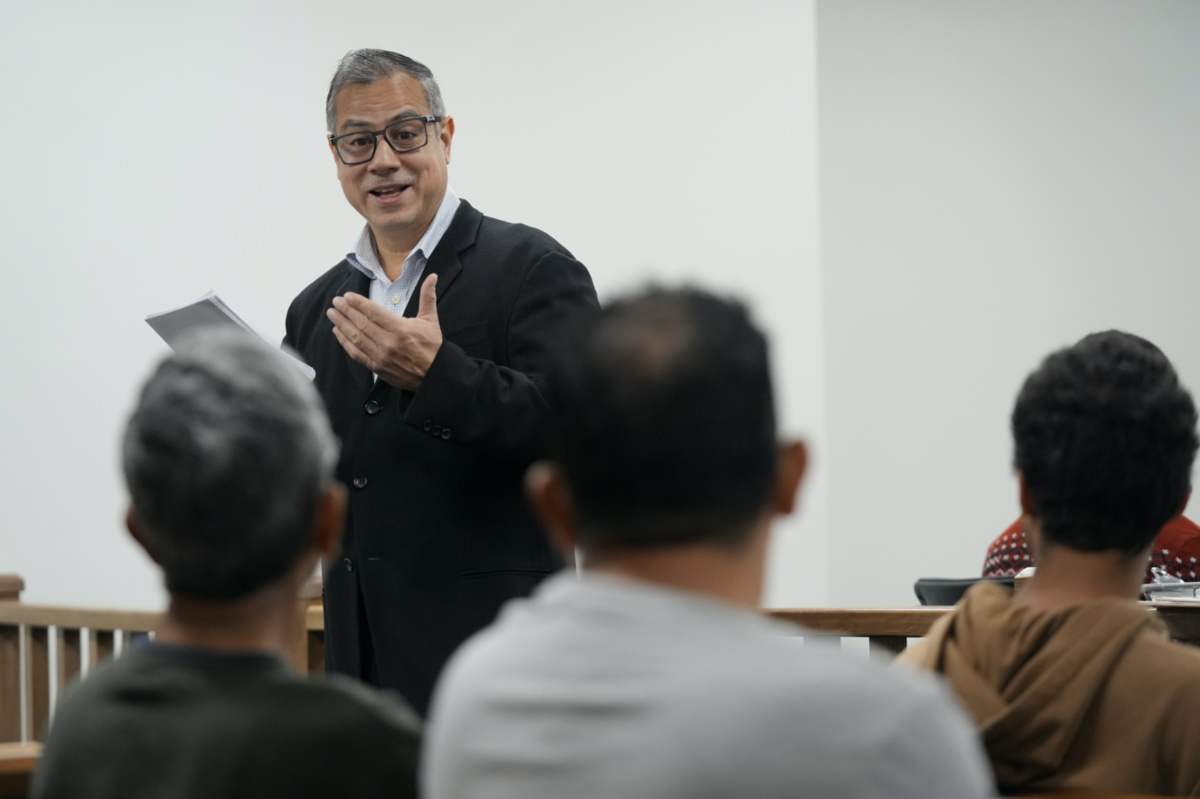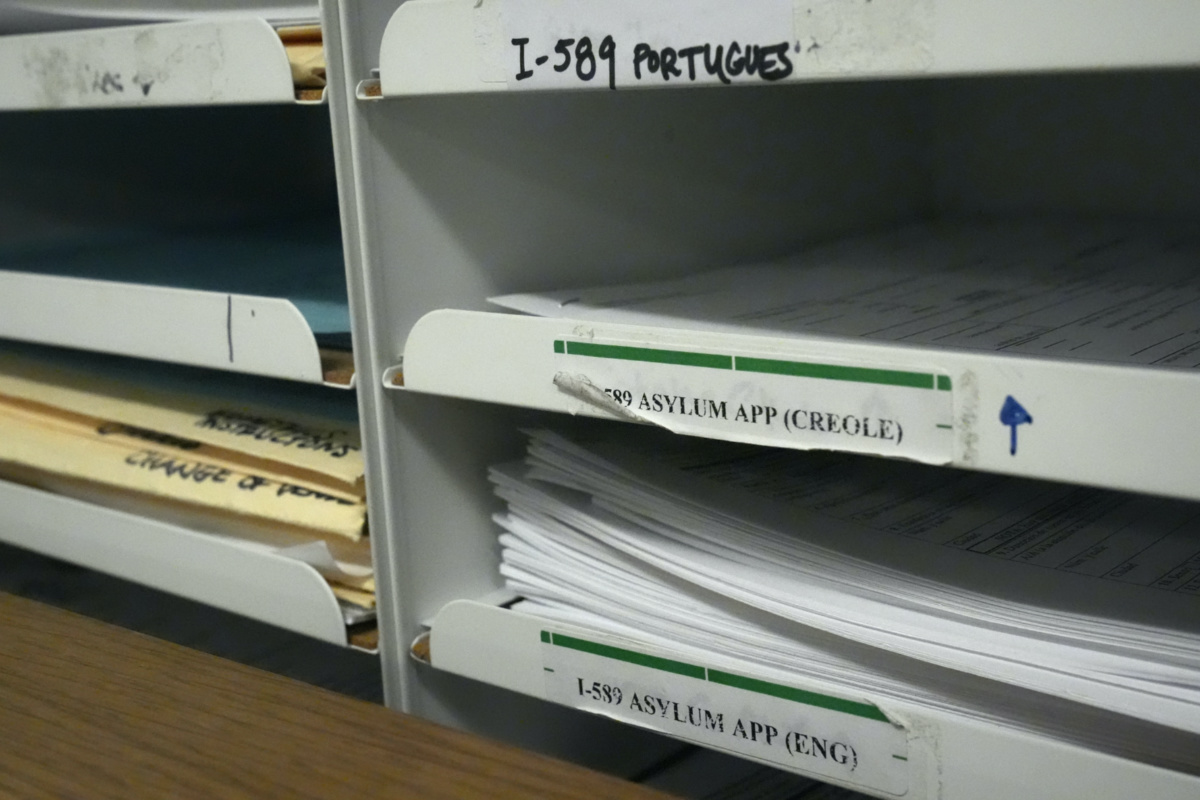
GIOVANNA DELL’ORTO, of Associated Press, reports on the huge backlog of cases in US immigration courts…
Miami, Florida, US
AP
Eight months after crossing the Rio Grande into the United States, a couple in their 20s sat in an immigration court in Miami with their three young children. Through an interpreter, they asked a judge to give them more time to find an attorney to file for asylum and not be deported back to Honduras, where gangs threatened them.
Judge Christina Martyak agreed to a three-month extension, referred Aarón Rodriguéz and Cindy Baneza to free legal aid provided by the Catholic Archdiocese of Miami in the same courthouse – and their case remains one of the unprecedented three million currently pending in immigration courts around the United States.

An officer directs people to a courtroom, Wednesday, on 10th January, 2024, in an immigration court in Miami. Immigration courts are buckling under an unprecedented three million pending cases, most of them newly arrived asylum-seekers. The number of migrants trying to fight their deportation in front of a US judge has grown by 50 per cent in less than a year. PICTURE: AP Photo/Wilfredo Lee.
Fuelled by record-breaking increases in migrants who seek asylum after being apprehended for crossing the border illegally, the court backlog has grown by more than one million over the last fiscal year and it’s now triple what it was in 2019, according to government data compiled by Syracuse University’s Transactional Records Access Clearinghouse.
Judges, attorneys and migrant advocates worry that’s rendering an already strained system unworkable, as it often takes several years to grant asylum-seekers a new stable life and to deport those with no right to remain in the country.

Alfredo Casapia, left, and Mayra Cruz speak during an interview on Wednesday, 10th January, 2024, in an immigration court in Miami. PICTURE: AP Photo/Wilfredo Lee.
“Sometimes hope already sinks…But here I’ve felt a bit safer.”
– Mayra Cruz, a Peruvian migrant.
“Sometimes hope already sinks,” said Mayra Cruz after her case was also granted an extension by Martyak because the Peruvian migrant doesn’t have an attorney.
“But here I’ve felt a bit safer,” added Cruz, who said she had to flee with only the clothes on her back with her partner and their children after repeated threats from gangs.
About 261,000 cases of migrants placed in removal proceedings are pending in the Miami court – the largest docket in the country. That’s about the same as were pending nationwide a dozen years ago, said Syracuse University professor Austin Kocher.
The backlog includes migrants who have been in the United States for decades and were apprehended on unrelated charges, but most are new asylum seekers who declare a fear of persecution if they are sent back, he added.
Backlogged courts, administered by the Justice Department, often get little attention in immigration debates, including in current Senate negotiations over the Biden administration’s $US110 billion proposal that links aid for Ukraine and Israel to asylum and other border policy changes.

Miguel Mora, a Catholic Legal Services supervising attorney, leads a workshops as part of a federal “help desk” program launched in two dozen immigration courts around the country, on Wednesday, 10th January, 2024, in Miami. PICTURE: AP Photo/Wilfredo Lee.
When migrants are apprehended by US authorities at the border, many are released with a record of their detention and instructions to appear in court in the city where they are headed. That information is passed on from the Department of Homeland Security to the Justice Department, whose Executive Office for Immigration Review runs the courts, so that an initial hearing can be scheduled.
“They’re just being released without any idea of what comes next,” said Randy McGrorty, executive director of Catholic Legal Services for the Archdiocese of Miami, which has seen hundreds of thousands of migrants join its diaspora communities.
So many migrants go to them for advice that, in the last couple of years, they’ve largely switched to teaching how to self-petition and represent themselves before judges.
“We help them understand what judges want, and we help judges with efficiency and preserving fundamental rights,” said Miguel Mora, a Catholic Legal Services supervising attorney in Miami.
Advocates say that most migrants ask for individual legal representation, something that’s becoming increasingly rare given the huge numbers, and how to get work permits, which migrants can apply for 150 days after filing their asylum application.
It’s a vicious cycle – without regular work, most can’t afford even a low-cost lawyer, so their cases can take even longer.
“We don’t have the money,” Rodriguéz, 23, told Judge Martyak, who had already granted him an extension for having no attorney at a previous hearing, as his partner rocked the stroller where their US-born baby slept. They fled Honduras after the gang that had killed the father of Baneza’s oldest child threatened further violence unless they started paying from the meager profits of their tortilla shop.
“We were left with no other option than get out of the country,” Rodriguéz told The Associated Press. “We’ve already had three court appearances. Time is helping. We’re getting a little bit oriented.”
But the slow-moving process also means it takes years for asylum-seekers to be able to reunite with families they left behind and integrate fully in American society, said Karen Musalo, an attorney and professor who leads the Center for Gender & Refugee Studies at the University of California in San Francisco.
Time also doesn’t help with the backlog, even though government records show judges completed far more cases in the last year than ever before, because their dockets keep growing so fast. Their average caseload is now 5,000 per judge, said Mimi Tsankov, president of the National Association of Immigration Judges.
She cited estimates that doubling the current number of judges to about 1,400 might solve the current backlog by 2032. In the new budget request, the Executive Office for Immigration Review is requesting funds from Congress to hire 150 new judges and support staff, said its press secretary, Kathryn Mattingly.

Asylum applications in different languages are shown, on Wednesday, 10th January, 2024, in a room used by Catholic Legal Services for the Archdiocese of Miami to help asylum-seekers at an immigration court in Miami. PICTURE: AP Photo/Wilfredo Lee.
Experts like retired judge Paul Schmidt, who also served as government immigration counsel while the last major reform was enacted nearly 40 years ago, say the broken system can only be fixed with major policy changes. An example would be allowing most asylum cases to be solved administratively or through streamlined processes instead of litigated in courts.
“The situation has gotten progressively worse since the Obama administration, when it really started getting out of hand,” said Schmidt, who in 2016, his last year on the bench, was scheduling cases seven years out.
We rely on our readers to fund Sight's work - become a financial supporter today!
For more information, head to our Subscriber's page.
In the mid-2010s, families and children from Central America seeking asylum became the majority of illegal crossers at the US southern border. In response, the Obama administration as well as the Trump and Biden administrations started prioritizing some categories of cases they want solved faster to reflect enforcement priorities.
But courts are ineffective deterrents to people desperate to flee their countries, and judges say shuffling cases around only adds to the chaos as they wade through dozens if not hundreds of cases a day.
At the courthouse in Miami last week, one judge went looking for a Haitian family who hadn’t shown up, then granted an order of deportation in absentia, just as she had for a Colombian family who also failed to appear at their hearing immediately before.
Another judge found that a Cuban mother, then a Venezuelan man had applied for other forms of protection special to their countries and dismissed their cases, telling them they were done with the court. The woman broke into grateful tears. The man, who had come more than 200 miles for the minutes-long hearing, mumbled “God bless you” in Spanish.
And a steady stream of migrants went to find Catholic Legal Services – one couple directed there by the judge to figure out how to present in court their video of the gang murder that had forced them to flee.
– With ELLIOT SPAGAT in San Diego, California.






